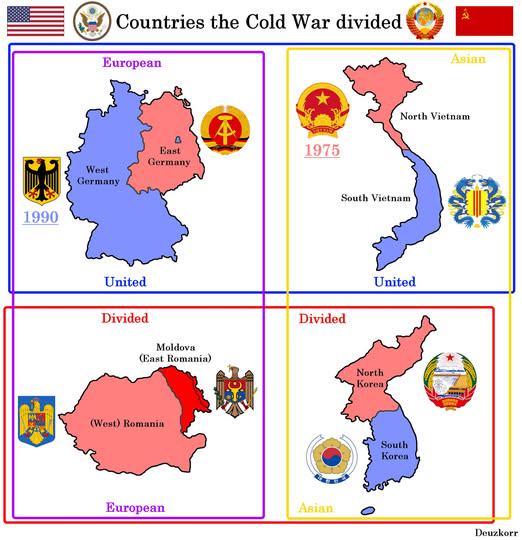Map of Countries Divided by WW2 and Cold War


David Chen
Data Visualization Specialist
David Chen is an expert in transforming complex geographic datasets into compelling visual narratives. He combines his background in computer science ...
Geographic Analysis
What This Map Shows
This map visually represents the geopolitical divisions of four countries—Germany, Korea, Vietnam, and Poland—resulting from the aftermath of World War II and the subsequent Cold War. Each of these nations has been profoundly shaped by their experiences during these tumultuous periods, leading to distinct historical paths that still influence their current political landscapes today.
Deep Dive into the Divisions
The effects of World War II and the Cold War on these countries illustrate the intersection of ideology, power struggles, and national identity. Germany is perhaps the most emblematic case, as it was divided into East and West after the war, symbolizing the broader ideological conflict between communism and capitalism. The West became a democratic state backed by the United States and its allies, while the East was under Soviet control, creating a stark division that lasted until the reunification in 1990.
Interestingly, this division had lasting impacts beyond just political governance; it fostered different cultural identities and economic systems that still resonate today. For instance, the economic policies in West Germany led to a booming economy known as the "Wirtschaftswunder," while East Germany struggled under central planning, resulting in significant disparities in wealth and quality of life.
Korea presents a similar narrative. Following the end of Japanese occupation in 1945, Korea was divided along the 38th parallel, leading to the establishment of North and South Korea. The Korean War (1950-1953) solidified this division, creating a heavily fortified border known as the Demilitarized Zone (DMZ). Today, North Korea remains an isolated, authoritarian regime, while South Korea has transformed into a vibrant democracy and a leading global economy. The stark differences between these two Koreas highlight how historical events can shape national trajectories dramatically.
Vietnam also experienced a division that was heavily influenced by the Cold War dynamics. Following the end of French colonial rule and the Geneva Accords in 1954, Vietnam was split into North and South, with the north being supported by communist allies and the south backed by the United States. The Vietnam War not only deepened this divide but also established a legacy of conflict and resilience. The reunification in 1975 marked a significant shift, leading to the socialist republic that Vietnam is today.
Poland's divisions were not as clear-cut as those in Korea or Vietnam but were deeply influenced by World War II's aftermath. The country was subjected to territorial changes and Soviet influence, which shaped its political landscape for decades. The Solidarity movement in the 1980s marked a significant push against communist rule, ultimately contributing to the broader collapse of Soviet-aligned regimes across Eastern Europe.
Regional Analysis
Examining these countries through the lens of their divisions reveals a fascinating tapestry of regional variations. In Germany, the legacy of division is most visible in the economic disparity between the former East and West. Cities like Berlin, which was once a divided city, continue to show signs of this historical split, with differing levels of investment and cultural initiatives.
When we look at Korea, the contrast is striking. South Korea’s capital, Seoul, is a bustling metropolis with a high standard of living, while Pyongyang, the capital of North Korea, is characterized by stark contrasts, with its grand monuments juxtaposed against widespread poverty and state control. This divide is not just physical but also deeply entrenched in the minds of the citizens who have grown up in these very different environments.
In Vietnam, the legacy of division can be analyzed through urban versus rural experiences. While major cities like Ho Chi Minh City exhibit rapid economic growth and globalization, rural areas still grapple with the remnants of war and socialist policies, demonstrating how the past continues to influence present-day realities.
Lastly, Poland’s experience in the post-communist era shows a successful transition to democracy and market economy, yet the shadows of its divided past linger, particularly in political polarization and regional disparities.
Significance and Impact
The divisions created by World War II and the Cold War continue to have profound implications for these nations and the world at large. Understanding how historical events shape national identity and governance is crucial in a globalized world. The narratives of Germany, Korea, Vietnam, and Poland serve as reminders of how conflicts can redefine borders and influence societal values.
As we move forward, it’s essential to consider how these historical divisions impact contemporary geopolitics. Current trends, such as rising nationalism and the re-evaluation of historical narratives, remind us that the echoes of the past are ever-present. Moreover, the reunification experiences of these countries provide valuable lessons on reconciliation, economic integration, and the quest for identity in a post-conflict world.
In conclusion, the map of countries divided by World War II and the Cold War is not just a representation of physical borders; it encapsulates complex histories, cultural shifts, and ongoing legacies that continue to shape the geopolitical landscape today.
Visualization Details
- Published
- October 2, 2025
- Views
- 48
Comments
Loading comments...